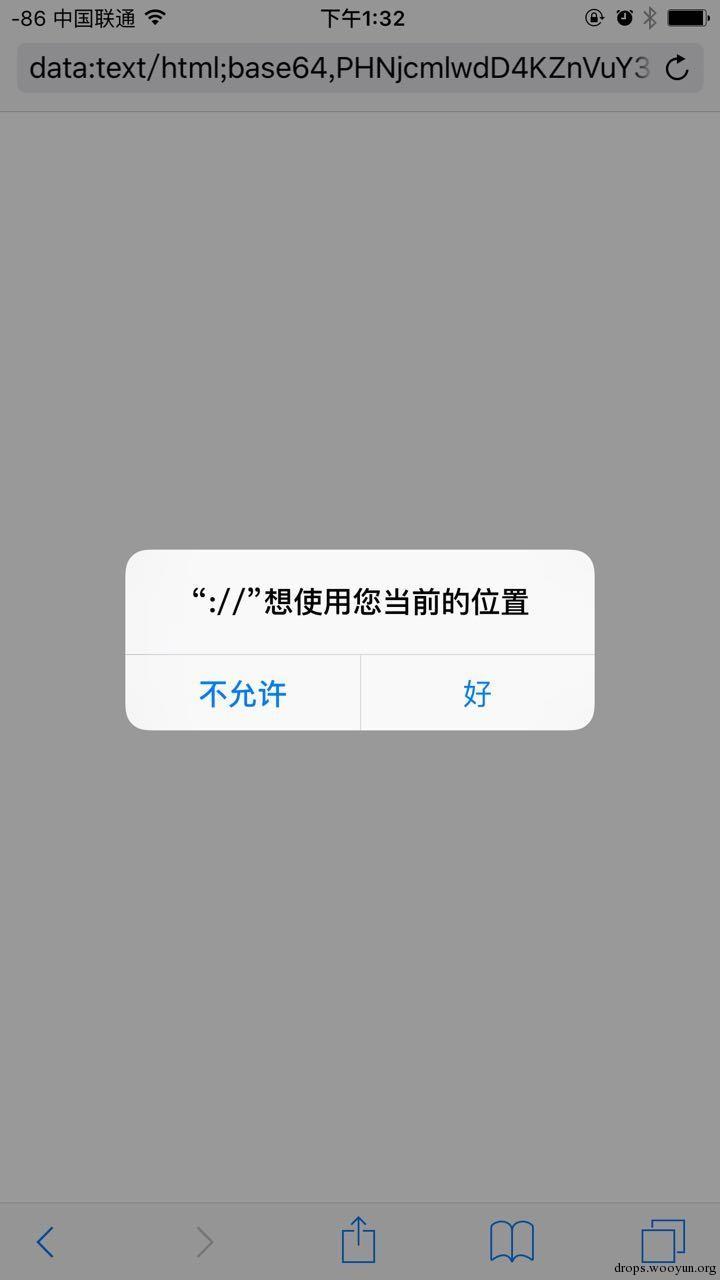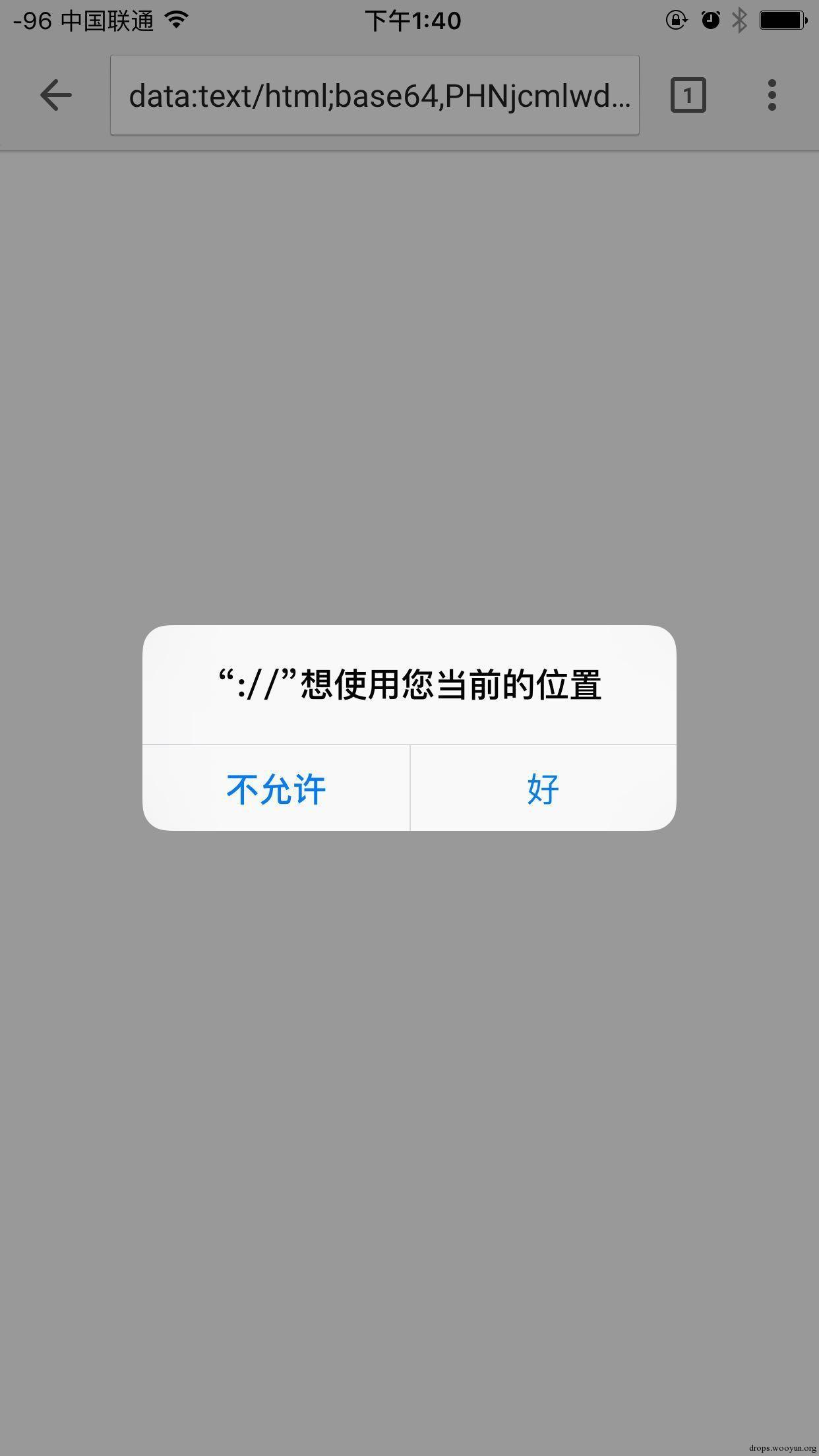# CVE-2016-1779技术分析及其背后的故事
**Author:xisigr@腾讯玄武实验室**
0x00 前言
=======
* * *
Geolocation API被用来获取用户主机设备的地理位置,并且它有一套完整的保护用户隐私的机制。但CVE-2016-1776这个漏洞,绕过了Geolocation认证源的安全机制,并有可能导致用户隐私泄漏。本文在分析CVE-2016-1779漏洞成因的基础上探讨了Geolocation隐私机制,其中穿插的获取苹果公司的地理位置的“故事”,对用户隐私更是一个警醒。
0x01 CVE-2016-1776
==================
* * *
在IOS中Geolocation认证是由UIWebView来做处理,攻击者可以绕过同源策略使认证框在任意域弹出,并且当用户点击允许后可获取到用户的地理位置。在IOS平台中,Safari和Chrome都受到这个漏洞的影响。
受影响产品:WebKit in Apple iOS < 9.3 and Safari < 9.1,Chrome
漏洞修复日期:2016/3/21
漏洞公告:
* [https://support.apple.com/HT206166](https://support.apple.com/HT206166)
* [https://support.apple.com/HT206171](https://support.apple.com/HT206171)
* [http://lists.apple.com/archives/security-announce/2016/Mar/msg00000.html](http://lists.apple.com/archives/security-announce/2016/Mar/msg00000.html)
* [http://lists.apple.com/archives/security-announce/2016/Mar/msg00005.html](http://lists.apple.com/archives/security-announce/2016/Mar/msg00005.html)
0x02 漏洞分析
=========
* * *
### 2.1 Geolocation API的安全隐私策略
在W3C官方文档描述中,可以清晰的了解到Geolocation API的安全隐私策略。其中下面这条和我们今天分析的CVE-2016-1776相关
> 4.1 Privacy considerations for implementers of the Geolocation API
>
> User agents must not send location information to Web sites without the express permission of the user. User agents must acquire permission through a user interface, unless they have prearranged trust relationships with users, as described below. The user interface must include the host component of the document's URI [URI]. Those permissions that are acquired through the user interface and that are preserved beyond the current browsing session (i.e. beyond the time when the browsing context[BROWSINGCONTEXT] is navigated to another URL) must be revocable and user agents must respect revoked permissions.
>
> [https://www.w3.org/TR/geolocation-API/](https://www.w3.org/TR/geolocation-API/)
这条安全策略明确指出:“Geolocation必须经过用户的许可才可以使用,除非已经预先确认了信任关系。浏览器在使用Geolocation时会弹出一个认证框来通知用户,并且在这个认证框的UI上必须包含此页面的URI。”对于这条策略,当下主流浏览器都已经实现。
### 2.2 认证框的源
触发Geolocation的认证框很简单,我们只要运行下面的代码即可,前提是之前没有允许当前域获取Geolocation。
```
```
例如:http://www.test.com/geo.html。运行后,浏览器会在当前页面上弹出认证对话框,对话框的UI上会显示来源:www.test.com。
### 2.3 PoC Exploit Code of CVE-2016-1779
在2.2中是触发Geolocation认证源的一个简单流程。从这个过程中,我有了以下的想法。
* 可否改变认证源。
* 如果可以改变,是否可以为空。
于是,按照这个思路,开始了我的测试之旅。在这个过程中,发现IOS下Safari和Chrome在使用`data:`来解析这段代码时,认证源头将为“`://`”
```
data:text/html;base64,PHNjcmlwdD4KZnVuY3Rpb24gc3VjY2Vzcyhwb3NpdGlvbikge30KbmF2aWdhdG9yLmdlb2xvY2F0aW9uLmdldEN1cnJlbnRQb3NpdGlvbihzdWNjZXNzKTsKPC9zY3JpcHQ+Cg==
```
safari:

chrome:

接下来,我进一步优化了POC,如下
```
test
```
Base64 decode:
```
geolocation
```
Safari:

Chrome:

还记得前面W3C官方文档对Geolocation认证源的描述吧,“认证框上的URI源,必须要和当前页面的源相同”。此时,我们已经成功的绕过了同源策略,使`data:`域的Geolocation认证源在其他任意域弹出。当用户点击允许后,系统也并没有检查认证UI上的源和当前页面源是否相同,于是地理位置就被发送到攻击者服务器了。
当时,我是先把这个漏洞报送给了Google,但由于Geolocation的认证100%是由IOS UIWebView来控制,所以Google对IOS平台下Chrome出现的这个问题也没有太好的解决方法。之后,我把这个漏洞提交给了APPLE。APPLE于今年3月21日在IOS 9.3版本中修复了这个漏洞。
0x03 廉价的苹果总部地理位置??
==================
* * *
在2016/1/6,我的服务器上收到了一些地理位置回传信息。因为在我提交的POC中明确的指出,使用自己的服务器搭建了一个漏洞验证环境,如果触发,数据则会传到我的服务器上。

在查阅后发现,37.332578830316436,-122.03068509201906,显示的正是APPLE的美国总部地址。

从获取到的返回数据可以发现,苹果研究人员分别在2016/1/6、2016/1/7、2016/1/8、2016/1/10、2016/1/20、2016/1/22、2016/1/28这7个时间段触发了POC,而且地址是相同的,都是在美国苹果总部。可能当时验证的苹果研究人员,并没有自己搭建漏洞验证环境,而是直接使用了我提供的POC中的原有环境,所以导致在验证漏洞的时候地理位置回传到了我的服务器上。
他们应该知道到这个问题,因为在POC中明确指出数据会回传到这个地址xisigr.com/test/geo/info.txt。但是,他们还是义无反顾的触发了7次漏洞,是疏忽大意还是并不在意苹果总部的地理位置被泄漏出去,因为这个地址在网上都可以任意查到。但就算是这样,我还是很惊讶,苹果测试人员的地理位置和他们的作息时间就这样被获取到了。
这当然不仅仅是一个故事,只是想提醒大家,在真实复杂的网络攻击中,蛛丝马迹的信息有时会成为“千里之堤毁于蚁穴”的突破口。不要让类似于地理位置这样重要的隐私信息变得如此廉价。
0x04 关于Geolocation其他想说的
=======================
* * *
### 4.1 HTTPS
Geolocation API被主流浏览器支持,已经有些年头,Geolocation API(getCurrentPosition()、watchPosition())一直支持可以在HTTP协议中使用。但随着互联网隐私安全越来越被重视,且还赶上了各大浏览器巨头们呼吁全网HTTPS的这样一个大背景,Geolocation API被提到了一个非安全源HTTPS中不能使用的高度。终于Google最先做出了表率,在2016年4月13日Chrome 50升级更新后,Chrome中不再支持非安全源HTTP下使用Geolocation API。

### 4.2 警惕插件扩展
Geolocation上的浏览器插件有很多,他们在使用“Geolocation”时对权限并没有考虑的那么周全,导致有可能泄漏用户的隐私。
* 认证源为空的攻击场景
在Firefox浏览器中,有一款地理定位的插件Geolocater,在最新版Firefox安装上后,会导致Geolocation认证源失效,也就是源变成了空。这是很可怕的事情,攻击者利用后,可以欺骗用户点击地理位置认证确认,进而获取到用户的地理位置。
Geolocater地址:[https://addons.mozilla.org/en-us/firefox/addon/geolocater/](https://addons.mozilla.org/en-us/firefox/addon/geolocater/)

我们来看下当认证源为空时的一个攻击场景:
假设www.test.com很安全,没有任何安全风险。且页面中存在这样的代码
```
----www.test.com----